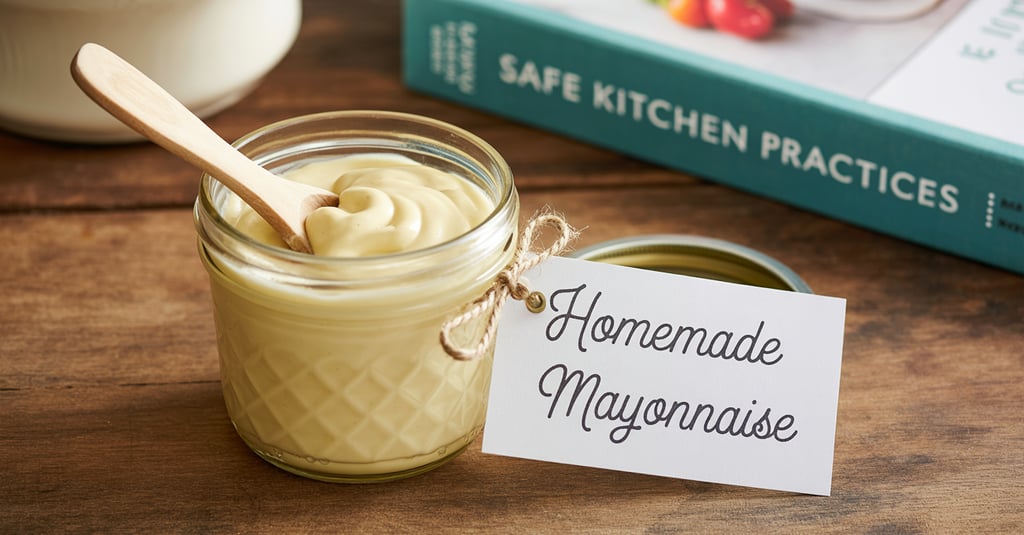Handling Raw Eggs in Dessert (Tiramisu) and Foods (Like Mayonnaise): Safety Guide
Raw eggs are a beloved ingredient in many traditional recipes — from the silky layers of Italian tiramisu to the creamy texture of homemade mayonnaise. They bring richness, structure, and flavour. But they also bring risk. Eating raw or undercooked eggs can expose you to Salmonella, a type of bacteria that causes food poisoning. This can be especially dangerous for children, older adults, pregnant women, and anyone with a weakened immune system. So, how do you enjoy those classic recipes without risking your health? This guide will show you how to safely handle, substitute, and prepare raw egg dishes while keeping all the deliciousness intact.
8/20/20253 min read


Why Raw Eggs Are Risky
Eggs can carry Salmonella bacteria inside the shell or on the shell’s surface. Unlike cooking (which kills the bacteria), raw egg recipes keep those microbes alive.
Symptoms of Salmonella infection may include:
Stomach cramps
Fever
Diarrhea
Nausea or vomiting
Most people recover, but severe cases can lead to hospitalization. That’s why food safety guidelines recommend avoiding raw or undercooked eggs.
Dishes That Often Use Raw Eggs
Some foods traditionally call for raw or lightly cooked eggs. Common examples include:
Tiramisu – Italian dessert with mascarpone and egg yolks.
Mayonnaise – Classic homemade versions use raw yolks.
Aioli – Garlic mayonnaise.
Caesar Salad Dressing – Authentic recipes use raw yolk.
Eggnog – Sometimes made with raw beaten eggs.
Mousse – Chocolate or fruit mousse often uses raw whipped eggs.
If you’ve ever made one of these, you’ve worked with raw eggs without cooking them to safe temperatures.
Safe Handling Tips for Raw Eggs
If you plan to use raw eggs, follow these steps to reduce risk:
1. Buy the Safest Eggs
Choose pasteurized eggs. They are heat-treated to kill Salmonella without cooking the egg.
Always check expiration dates.
Store eggs in the refrigerator at 40°F (4°C) or below.
2. Keep Them Cold
Keep eggs in their carton (not in the door) to maintain consistent temperature.
If your recipe takes time (like tiramisu), keep bowls refrigerated between steps.
3. Practice Good Hygiene
Wash hands thoroughly after touching raw eggs.
Clean and sanitize any surfaces, utensils, or bowls that touch raw egg.
Avoid cross-contamination with other foods, especially ready-to-eat foods.
4. Use Immediately
Don’t leave raw egg dishes at room temperature longer than 2 hours.
Store finished desserts (like tiramisu) in the fridge until serving.
How to Make Tiramisu Safely
Traditional tiramisu uses raw yolks for creaminess. Here are safer alternatives:
Option 1: Use Pasteurized Eggs
Pasteurized eggs can be used raw in tiramisu without the Salmonella risk.
Available in many supermarkets (sometimes in cartons).
Option 2: Cook the Egg Yolks
Make a sabayon (custard base): whisk egg yolks with sugar over simmering water until the mixture reaches 176°F (80°C).
Then fold in mascarpone and whipped cream.
The result? Same creamy texture, but safer to eat.
Storage Tip
Always refrigerate tiramisu at least 4 hours before serving.
Consume within 2–3 days.
How to Make Mayonnaise Safely
Option 1: Use Pasteurized Egg Yolks
Just like tiramisu, pasteurized yolks can be used raw.
Option 2: Use a Cooked Egg Base
Whisk egg yolk with lemon juice over gentle heat until it reaches 176°F (80°C).
Cool slightly, then blend with oil to form mayonnaise.
Option 3: Egg-Free Mayonnaise
Blend milk (or soy milk), vinegar, mustard, and oil → creamy, safe alternative.
Storage Tip
Homemade mayo (with pasteurized eggs) lasts up to 3 days refrigerated.
If using raw unpasteurized eggs (not recommended), consume within 24 hours.
Substitutes for Raw Eggs in Recipes
If you can’t find pasteurized eggs, try these substitutions:
For Mayonnaise/Dressings: Use yogurt, sour cream, or silken tofu as the creamy base.
For Tiramisu/Mousse: Use whipped cream or whipped aquafaba (chickpea water) to replace raw egg whites.
For Eggnog: Use a cooked custard base with milk, sugar, and cooked egg yolks.
Who Should Avoid Raw Eggs Completely!!!!
Certain groups should never consume raw or undercooked eggs:
Pregnant women
Infants and young children
Older adults (50+)
People with weakened immune systems
For these groups, always use pasteurized eggs or cooked alternatives.
FAQs About Raw Eggs
1. Are raw eggs safe if they’re organic?
No. Salmonella risk exists regardless of farming method.
2. Can lemon juice or alcohol kill bacteria in egg-based recipes?
No. Acid and alcohol slow bacteria growth, but they don’t make raw eggs safe.
3. What’s the safest way to eat traditional recipes?
Use pasteurized eggs or cook the egg mixture to 176°F (80°C).
Raw eggs bring flavour and tradition to recipes like tiramisu and mayonnaise, but they also bring risk. The good news? With pasteurized eggs, cooked bases, and proper storage, you can enjoy these classics without worry.
Key Takeaways:
Always choose pasteurized eggs for raw dishes.
Keep eggs cold and follow strict hygiene practices.
Avoid raw eggs entirely if you’re in a high-risk group.
By following these simple food safety practices, you can keep enjoying tiramisu, mayonnaise, and other favorites - with all the flavor, and none of the fear.
Join us on Pinterest
letstalk@lorybs.com
© 2025. All rights reserved.
